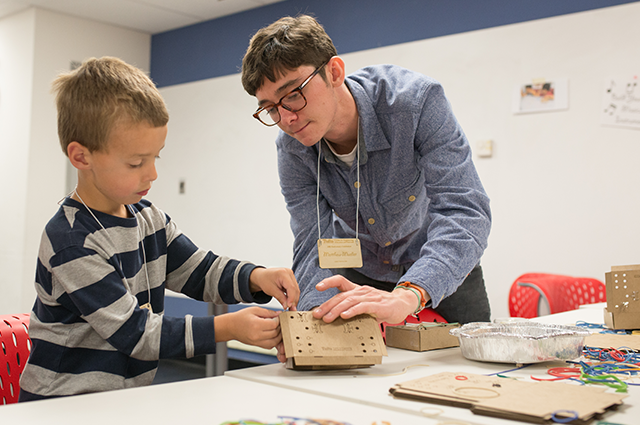How outreach ambassadors impact the next generation of engineers

The Tufts Center for Engineering Education and Outreach (CEEO) is committed to fostering the next generation of engineers through innovative research and educational initiatives. Tufts CEEO Director Merredith Portsmore and researchers from Indiana University received a National Science Foundation (NSF) grant in 2017 to fund a project focused on studying engineering outreach at the elementary level. Titled “Role Models in Elementary Engineering Education,” the project investigates engineering outreach educators as role models and educators. The researchers analyzed interactions between educators and students to understand what factors may contribute to the effective facilitation of an engineering activity that supports young students in seeing engineering as a possible future.
Citing research that many girls lose interest in engineering around middle school, the grant focuses specifically on engineering education initiatives for elementary-aged students as a critical age in developing and cultivating interest in engineering. According to the grant, “This research will inform an iterative process of designing resources and training to prepare outreach ambassadors in engineering and optimize their interactions with elementary students.”
The project has produced several academic papers, including one recently published in the Journal of Engineering Education. First author and Tufts alum Karen Miel, A21, former Tufts CEEO postdoctoral researcher Rebecca Swanson, Portsmore, and Tufts alum Elizabeth Moison, A21, collaborated with researchers from Indiana University to analyze the talk moves of undergraduate outreach educators. While there has been extensive research in the overarching goals, methods, and effectiveness of engineering outreach programs, the specific discourse of engineering outreach educators’ delivery of these programs has been less studied.
The researchers analyzed the speech patterns of engineering educators and their interactions with students as they delivered hands-on design activities to elementary school students. Their teaching moves were sorted into three categories: ambitious, conservative, and inclusive. Ambitious moves center student-directed thinking and sharing, conservative moves guide the students to the engineering educator’s perspective, and inclusive moves support the inclusion of all students in the project. The researchers found that the undergraduate outreach educators used primarily ambitious and conservative moves to support student learning and engagement. The paper asserts that both types of moves are likely necessary to support students in learning to engage in engineering and feel that they can be successful in engineering.
The work builds on a previous paper supported by the NSF grant and presented at the 2020 American Society of Engineering Education (ASEE) conference by Moison, Miel, and Portsmore in collaboration with researchers from Indiana University Bloomington. That paper also studied the effectiveness of different teaching moves for engineering outreach educators. Other Tufts research supported by this grant include a paper by undergraduate alum Annmarie Hoch, A21, Miel, and Swanson, titled “’Because I’m Not Always Constantly Getting Everything Right’: Gender Differences in Engineering Identity Formation in Elementary Students”, as well as 2019 paper “Maybe If I Put My Mind To It": 5th Graders’ Receptivity to Pursuing Engineering Careers”, which won best paper in the Pre-College Engineering Education Division at the ASEE Conference.
While the researchers delve into the details of speech patterns and phrases in their most recent publication, the impact of this project has major implications for the field of engineering as a whole. Ultimately, by refining the quality of engineering outreach for elementary school students, the researchers hope to increase chances of young people, particularly girls, retaining an interest in engineering throughout their education and potentially pursuing engineering as a career path.
The content of this article is solely the responsibility of the authors and does not necessarily represent the official views of the National Science Foundation. Research reported in this article was supported by the National Science Foundation, under award number 1657509.
Department:
Center for Engineering Education and Outreach